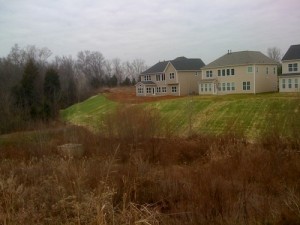Stormwater Management Research
Ongoing Research

Mill Creek, near Cleveland, Ohio is intensely urbanized. How well does stormwater management mitigate the hydrologic and water quality effects of the landscape’s development?
From 2017-2023, I was the principal investigator of a National Science Foundation-funded grant to study how stormwater decision making translates to environmental outcomes at the watershed scale. I’m collaborating with Aditi Bhaskar (University of Colorado), Kelly Turner (UCLA), and Dave Costello (Kent State University) on the project we’ve nicknamed STORMS, for STream Outcomes Resulting from Management of Stormwater. You can read more about the project’s design and goals here. We worked in Cleveland and Denver using approaches drawn from social sciences, engineering, geology, and biology to develop an integrative understanding of urban watershed function.
Zia Ul Hassan’s PhD dissertation focused on modeling the implications of green infrastructure and climate change for the hydrology of urban watersheds in Cleveland and Denver.Suffiyan Safdar is using turbidity data collected during the STORMS project to understand the controls on suspended sediment dynamics in Cleveland urban streams.
Related publications:
- Turner, V.K., Gmoser-Daskalakis, K., Costello, D., Jefferson, A., and Bhaskar, A. 2022. Champions and Traditional Technocrats: The Role of Environmental Value Orientation in Stormwater Management. Journal of the American Water Resources Association, 58(3):336-354, doi: 10.1111/1752-1688.13015.
- Avellaneda, P.M. and Jefferson, A.J. 2020. Sensitivity of streamflow metrics to infiltration-based stormwater management networks. Water Resources Research. 56(7): e2019WR026555. doi:10.1029/2019WRR026555
- Bell, C.D., Wolfand, J., Panos, C., Bhaskar, A., Gilliom, R., Hogue, T., Hopkins, K.G., Jefferson, A.J. 2020. Stormwater control impacts on runoff volume and peak flow: A meta-analysis of watershed modelling studies. Hydrological Processes. 34(14): 3134-3152. doi:10.1002/hyp.13784
Recent Projects
Reviews: In 2017, we synthesized and reviewed 100 studies reporting catchment scale effects of stormwater management networks to understand the state of the science. This work was followed by a meta-analysis of modeling studies in 2020.
- Jefferson, A.J., Bhaskar, A., Fanelli, R., Hopkins, K.G., Avellaneda, P.M., and McMillan, S.K. 2017. Stormwater management network effectivenesss and implications for urban watershed function: a critical review. Hydrological Processes. 31 (23): 4056–4080, doi:10.1002/hyp.11347.
- Bell, C.D., Wolfand, J., Panos, C., Bhaskar, A., Gilliom, R., Hogue, T., Hopkins, K.G., Jefferson, A.J. 2020. Stormwater control impacts on runoff volume and peak flow: A meta-analysis of watershed modelling studies. Hydrological Processes. 34(14): 3134-3152. doi:10.1002/hyp.13784
- O’Driscoll, M., Clinton, S., Jefferson, A., Manda, A., and McMillan S., 2010, Urbanization Effects on Watershed Hydrology and In-Stream Processes in the Southern United States, Water, 2 (3): 605-648. doi:10.3390/w2030605.
Site scale: With funding from Cleveland Metroparks and Kent State University, our research group explored the effectiveness of different types of green infrastructure on mitigating stormwater flows and improving water quality at the site scale. Multiple students collected and analyzed five years of water quantity and quality data for two bioretention cells, the green roof, and a constructed wetland at the Cleveland Metroparks Watershed Stewardship Center, in collaboration with Lauren Kinsman-Costello‘s lab. With Dave Costello and his students, we also investigated metal accumulation in bioretention cell soils.
- Costello, D., Hartung, E.W., Stoll, J.T., and Jefferson, A.J. 2020. Bioretention cell age and construction style influence stormwater pollutant dynamics. Science of the Total Environment. 712: 135597, doi:10.1016/j.scitotenv.2019.135597
Street scale: Bioretention cells capturing street runoff and rain gardens and rain barrels collecting roof runoff have been installed on two residential streets in the City of Parma’s West Creek watershed. Using a paired watershed approach, graduate student Kimm Jarden examined the effectievness of this retrofit in reducing peak flows and total stormflow volumes. You can read about the results of her work in a paper in Hydrological Processes, or the accompanying press release. Post-doc Pedro Avellaneda built on the experimental data to develop a hydrological model of one of the streets and assess which parts of the project generated the largest benefits. We also explored the social science dimensions of this project in a paper with Kelly Turner (UCLA).
- Jarden, K.M., Jefferson, A.J., and Grieser, J.M. 2016. Assessing the effects of catchment-scale green infrastructure retrofits on hydrograph characteristics. Hydrological Processes, 30(10):1536-1550. doi: 10.1002/hyp.10736.
- Turner, V.K., Jarden, K.M., and Jefferson, A.J., 2016. Resident perspectives on green infrastructure in an experimental suburban stormwater management program. Cities and the Environment, 9(1): art. 4.
- Avellaneda, P.M., Jefferson, A.J., Grieser, J.M. and Bush, S.A., 2017. Simulation of the cumulative hydrological response to green infrastructure. Water Resources Research. 53: 3087–3101, doi:10.1002/2016WR019836.
Downstream effects in headwater catchments: Funded by NSF’s Environmental Sustainability program from 2010-2015, Anne was part of an interdisciplinary team investigating the influence of stormwater management structures on ecological function in urban streams. This project was in collaboration with Sara McMillan at Purdue, Sandra Clinton at UNC Charlotte, and Christina (Naomi) Tague at UC Santa Barbara. We used a combination of monitoring and modeling to understand the cumulative, downstream effects of stormwater control structures on urban stream hydrology, biogeochemistry, and ecology on urban headwater streams.
- Scarlett, R, McMillan, S., Bell, C., Clinton, S., Jefferson, A., and Rao, P.S.C. 2018. Influence of Stormwater Control Measures on Water Quality at Nested Sites in a Small Suburban Watershed. Urban Water Journal, 15:9, 868-879, DOI: 10.1080/1573062X.2019.1579347
- Bell, C.D., McMillan, S.K., Clinton, S.M., and Jefferson, A.J., 2017. Characterizing the Effects of Stormwater Mitigation on Nutrient Export and Stream Concentrations. Environmental Management. 59: 604-618. doi:10.1007/s00267-016-0801-4.
- Bell, C.D., McMillan, S.K., Clinton, S.M., and Jefferson, A.J., 2016. Hydrologic response to stormwater control measures in urban watersheds. Journal of Hydrology. 541: 1488-1500. doi: 10.1016/j.jhydrol.2016.08.049.
- Jefferson, A., Bell, C., Clinton, S., and McMillan, S. 2015. Application of isotope hydrograph separation to understand urban stormwater dynamics, Hydrological Processes, 29(25): 5290-5306. doi: 10.1002/hyp.10680.

